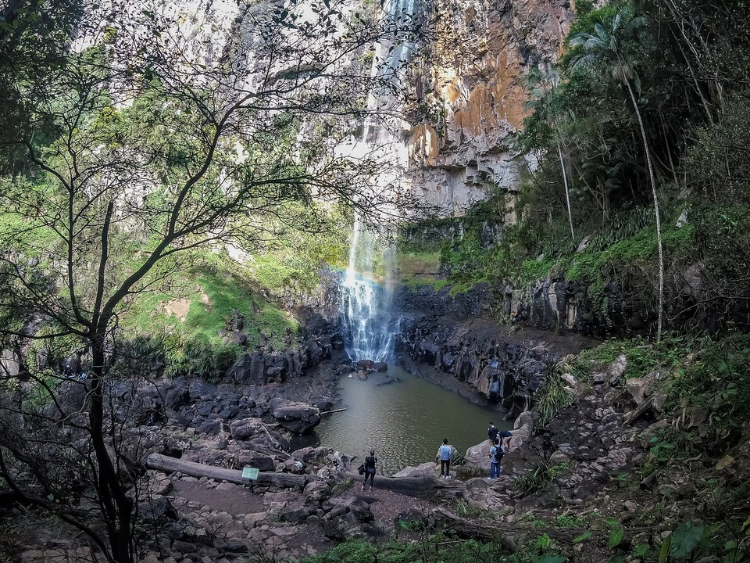
Springbrook National Park is located in the Gold Coast hinterland of Queensland, Australia. It's about a 45-minute drive from the Gold Coast and approximately 90 minutes from Brisbane, the state capital. This national park is renowned for its lush rainforests, cascading waterfalls, stunning lookouts, and diverse wildlife.

Springbrook National Park was established in 1990.
Springbrook National Park has a rich history and ecological significance. It forms part of the Gondwana Rainforests of Australia World Heritage Area, which encompasses several rainforest reserves and national parks in Queensland and New South Wales. The park's ancient forests are home to a diverse range of plant and animal species, including rare and endemic ones. Its waterfalls, such as Purling Brook Falls and Twin Falls, attract visitors for their beauty and tranquility. Additionally, Springbrook National Park offers numerous walking tracks, scenic lookouts, and opportunities for birdwatching and nature appreciation.

Springbrook National Park was not "invented" by a single person. Rather, it was established through the efforts of conservationists, government officials, and local communities who recognized the ecological importance of the area and worked together to protect it. The park's creation involved a process of land acquisition, conservation planning, and official designation as a protected area under Queensland's national park system.


Springbrook National Park derives its name from the small community of Springbrook, which is located within the park's boundaries. The name "Springbrook" likely originated from the numerous freshwater springs found in the area, which feed the waterfalls and creeks within the park. These springs are a vital part of the park's ecosystem, providing water for the lush rainforests and sustaining the diverse wildlife that inhabits the region.




Springbrook National Park is a paradise for hiking lovers for several reasons:
1. **Scenic Trails**: The park boasts a network of well-maintained hiking trails that wind through ancient rainforests, past cascading waterfalls, and along rugged escarpments. These trails offer stunning views of the surrounding landscape and provide hikers with opportunities to immerse themselves in nature's beauty.
2. **Diverse Terrain**: Hikers can explore a variety of terrain within the park, from lush subtropical rainforests to open eucalyptus forests and rocky cliffs. This diversity of landscapes makes each hike unique and exciting.
3. **Waterfalls**: Springbrook National Park is home to several breathtaking waterfalls, including Purling Brook Falls, Twin Falls, and Natural Bridge. Hiking trails lead to many of these waterfalls, allowing hikers to enjoy both the journey and the destination.
4. **Wildlife Viewing**: The park is teeming with wildlife, including colorful birds, elusive mammals, and fascinating reptiles. Hikers may encounter native species such as pademelons, brush turkeys, and lace monitors along the trails.
5. **Peace and Serenity**: With its remote location and pristine natural surroundings, Springbrook National Park offers a peaceful retreat from the hustle and bustle of city life. Hikers can enjoy the tranquility of the forest and experience a sense of connection with the natural world.
Overall, the combination of scenic beauty, diverse terrain, and abundant wildlife makes Springbrook National Park an ideal destination for hiking enthusiasts seeking adventure and exploration.







Yes, Springbrook National Park is indeed suitable for hiking throughout the year. However, there are a few things to consider when planning a hike:
1. **Weather**: The Gold Coast region, where Springbrook National Park is located, typically experiences a subtropical climate with mild winters and hot, humid summers. The weather can be unpredictable, so it's essential to check the forecast before heading out. During the summer months (December to February), temperatures can soar, and heavy rainfall is common, which may affect trail conditions. In contrast, winter (June to August) generally offers cooler and drier weather, making it an excellent time for hiking.
2. **Crowds**: Peak tourist season in the Gold Coast typically occurs during the Australian school holidays and major holidays like Christmas and Easter. During these times, the park may be more crowded, especially popular areas like the waterfalls and lookout points. If you prefer quieter hiking experiences, consider visiting during the shoulder seasons (spring and autumn) when the weather is still pleasant, but there are fewer visitors.
3. **Trail Conditions**: Some trails within the park may be affected by weather conditions, particularly after heavy rainfall. Certain trails, especially those leading to waterfalls or along creek beds, may become slippery or impassable during wet weather. Always exercise caution and check trail conditions with park authorities before embarking on a hike, especially during the rainy season.
Overall, while Springbrook National Park offers hiking opportunities year-round, it's essential to plan accordingly based on the weather, crowds, and trail conditions to ensure a safe and enjoyable experience.